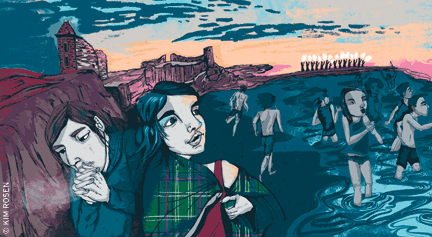
“I didn’t register how cold it really was until my head was under.”
By Anna Strong
The night of April 30, 2010 began with a procession. The entire student body, wearing red academic gowns and carrying torches, converged on the pier at twilight, coming from all corners of the town, empty of locals at that hour. We walked from the top of North Street, out onto the pier, and back again in memory of John Honey, who in the winter of 1800 had spotted a ship in distress from the pier and swum out five times to save the drowning crew.
The pier extended into the North Sea from East Sands. Looking west, we saw the low stone rooftops of St. Andrews cutting a jagged gothic line against the paling sky. To the east was only the sea, which caught every color the sun had left behind only minutes before.
The pier was only wide enough for two people to walk next to each other. My roommate and best friend Phoebe and I walked together, watching both our torches and our step. All I could think about was someone tripping on the uneven stone and igniting another person’s gown, or worse, falling 30 feet into the sea below. But when we reached the end of the pier and prepared to turn around, we paused for a moment to look out at what lay below us. “Did you ever imagine you’d be here?” Phoebe asked.
“Never in a million years,” I said.
When I started applying to colleges, I thought I knew everything. I thought I knew exactly which schools were in reach for me and which ones weren’t, I knew what I wanted to major in (English), and I knew that I wanted to write (creatively, journalistically, critically, any type of writing I could possibly do). The problem was, and still is: I’m bad at math. Epically, hilariously bad at math. It was, I can only guess, this ineptitude that barred me from all the colleges I wanted to attend—all those schools with their commitments to the liberal arts, to the well-rounded student. By the end of my application process, I had nine rejection letters and three acceptance packets: Kenyon College, Boston University, and the University of St. Andrews. I couldn’t imagine three more different schools, and while each had its pros and cons, by the time I was finally ready to choose, I was tired of being told no because I couldn’t do math. I wanted a school that was going to accept me because of what I could do well.
St Andrews admitted me for my strengths, promised me that I’d never, ever, have to open a physics textbook or see a calculus problem again, and told me, “Yes, Scotland is far away from home, but don’t you want to look out of the window of a classroom and see a castle that was built in the 12th century? Don’t you want to be a part of the 600th graduating class? Don’t you want to process to the end of the pier for a tradition that’s nearly as old as the country you’ll leave behind?”
I said yes to all of those questions, and I went to Scotland.
And for the first semester it was perfect. All I did was read, write essays, look at paintings, and pick up a new language. But by the end of the first semester, I was beginning to miss other things. Not math, not yet, but I was missing history, for one. And was I really never going to be able to take a psychology course, just for fun? I didn’t want to give up my major, but being told that my major was all I could do for the next four years was scary.
I felt restless. I found myself constantly looking for reasons to justify why I had leapt across the Atlantic. “I wanted something different” wasn’t enough anymore. The professors were good, but I didn’t feel like they were interested in their first-year students. I could travel, I could legally go to bars, the town itself was beautiful, and I had made some amazing friends, but all of those benefits did not outweigh what I had given up: academic challenges. I realized I had taken a shortcut, the easy way out, and the last thing I wanted was to look back on my college career and say, “That was easy.”
I submitted applications for transfer in February, and on the night of the Gaudie procession I was still waiting to hear back from schools. My friends and I hadn’t talked about me leaving much. We didn’t want to—and especially on that night, we just wanted to enjoy what was ahead, and not think about the fact that this might be the beginning of the end of our time together. The word “bittersweet” had never been more appropriate.
At first light on every May 1—about 4:15 at that time of year—some 3,000 St. Andrews students charge into the North Sea. And so we gathered on Castle Sands, a rocky beach in the shadow of St. Andrews Castle. The beach is shaped like a crescent, and provides enough of an enclave that it’s protected from the wind, but the water is a little rougher than it is at the more open beaches.
There were ten of us who had promised to do the Dip together and we stood on the rocky beach with the rest of the student body, shivering with both cold and anticipation, waiting for the first rays of sunlight to illuminate the dark, distant horizon. Phoebe and I each had at least three layers on, reckoning that we’d be beyond freezing on our way back to our dorm (we guessed right).
We stood in a circle, staking out a place on the beach to pile all of our clothes while we were swimming. We were all looking toward the horizon, all waiting for the signal to strip to our swimsuits and run into the ocean. “Bring it in,” one of our group said, motioning for us all to huddle together. “This is it. Last chance. If we’re all in, let’s all grab hands and go. We’ve all got to run together or we’ll chicken out.”
People around us were starting to take off their clothes. There was a nervous energy in everyone’s voice, and just as we were down to our last layers, we heard the first splashes of people running into the water. The light was just bright enough that it illuminated the caps of the small waves the swimmers left in their wake.
“Now or never,” I said. We ran in, screaming probably louder and more shrilly than I remember. I didn’t register how cold it really was until my head was under, and then I really felt it grab hold of my lungs and squeeze. I launched myself off the bottom and lunged forward in one motion, my only impulse to get out of the water, to find my towel and get dry.
Phoebe was right next to me, and we ran back to shore, fueled by the thought of the warmth that was only seconds away. For a few minutes, we couldn’t say anything. Our teeth were chattering too violently to allow for any kind of speech. But the wild look in our eyes said it all—that we’d just done something both exhilarating and colossally stupid, but we weren’t feeling cold, we were feeling free.
On May 13, I found out that I had been admitted to Penn as a transfer student in the class of 2013. My year in Scotland taught me that the most important thing we can do is take chances, and the May Dip, if nothing else, was the capping moment of that year of doing things just because I was in a new place with new rules and new friends, and I could. But St. Andrews came with restrictions. The course of study that I thought would be so freeing because it would be math-less turned out to be the biggest constriction of all. I was ready to give up formulas and graphing calculators, but I was not ready to give up everything else, and my decision to move to Penn for the rest of my collegiate career was really the point where I came full circle—from resenting the liberal arts to finally seeing why they made perfect sense for me. Ultimately, college is both about taking chances and being challenged, and only at Penn have I found those two to be in balance.
Though I might be a little less sanguine about that when final exams come round this year: this summer, I am finally taking calculus.
Anna Strong is a junior from Haverford, Pennsylvania. She won the Penn Publications Cooperative’s “Best Leisure Interest Piece” award in 2011, for a short fictional story that appeared in The Penn Review.




